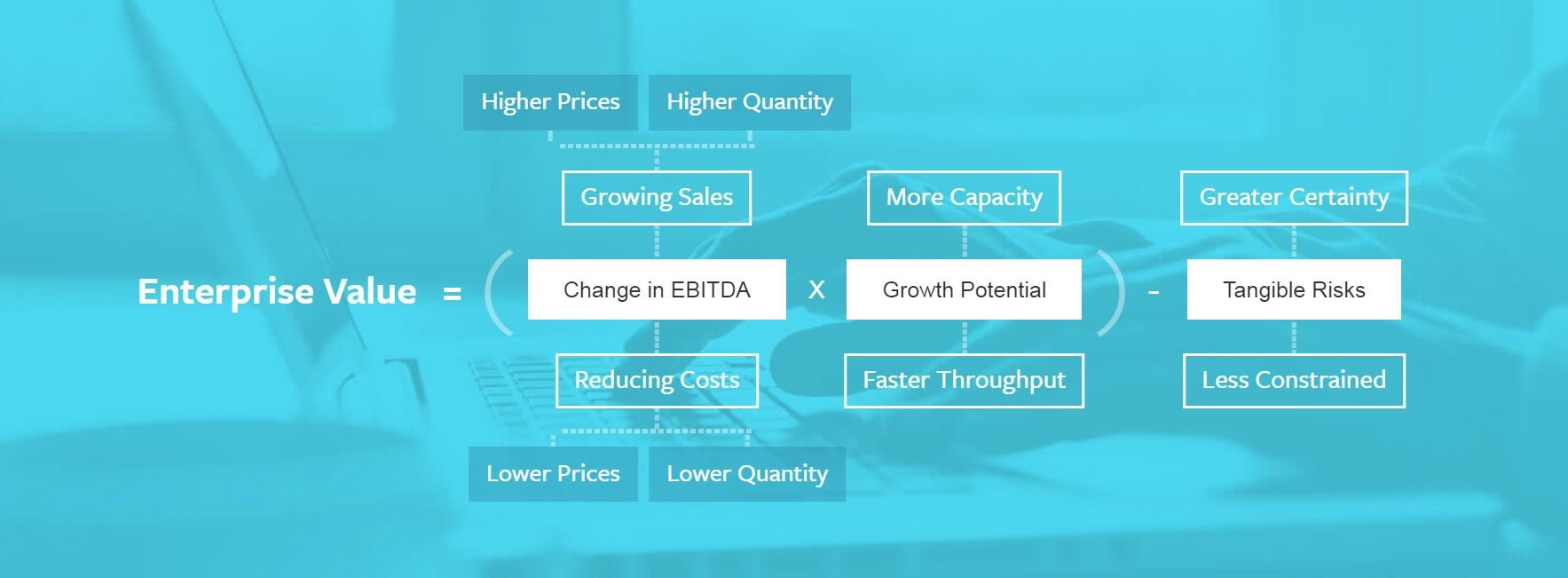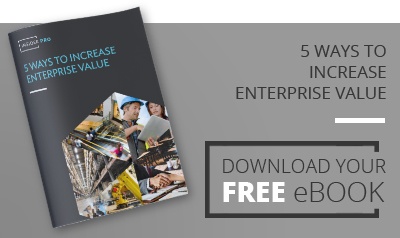"Enterprise Value" is a term that is used to value a business beyond it's market capitalisation. The usual definition is market capitalisation (share price multiplied by the number of outstanding shares) plus net debt.
But we think that enterprise value can and should be looked at in an entirely different way....
We would argue that if an investor is trying to compare the value of two businesses, the share price doesn't really tell them much. And if the business is of a size that it hasn't publicly released shares yet, then the "traditional" calculation falls down.
Instead, we think a better measure of Enterprise Value, and one that can be used to value ANY size of business is:
(Change in EBITDA multiplied by Growth Potential) less Tangible Risks
Let's examine each element of this equation:
1. Change in EBITDA
EBITDA is earnings before interest, taxes, depreciation and amortisation. It's often stated in year end reports and the change in EBITDA is the change from one year to the next.
2. Growth Potential
This is a measure of how much the business is expected to continue to grow over the next period. This will be impacted by the size of the market, production capacity, finances to support growth and other elements.
However, in setting financial targets, most companies have already figured out a realistic growth potential and use this to set budgets for revenue and margin.
3. Tangible Risks
This element is sometimes overlooked, but hugely important when valuing a business.
For example, a business that is completely reliant on imports from Europe in the time leading up to Brexit will assign a much higher risk factor than one in the same industry doing the same thing with UK sourced materials.
Having identified Enterprise Value, what are the key ways to improve it?
The diagram below shows the levers that businesses can use to improve enterprise value and grow their business.

1. Grow sales value by raising prices
This is usually only an option if the market will stand it, or if you can change the product to make it more appealing to the customer and therefore of higher value to them. In very rare cases, making something more expensive can actually make it more appealing to the market!
In the private care sector, adding low cost services such as social events to the standard offering can attract a higher per resident price, for example.
2. Grow sales value by selling more
Selling the same products into new markets, new products into the same markets, and/or simply selling more of the current product to the current market. To be successful, sales and production/ operations teams need to work together to develop and sell the right products for the market.
In the casual dining sector, more beer is sold if it is maintained at the right temperature. Monitors on fridges to provide alerts when stocks are low or temperatures are out of tolerance can positively impact sales!
3. Reduce costs by lowering the price paid
This is an interesting one. Lower prices are not necessarily the result of renegotiating the price of the same items. Lower costs can be achieved through build vs buy decisions, outsourcing services or by working to reduce the total operating cost of an asset rather than simply it's purchase price. We call this disruptive procurement.
4. Reduce costs by lowering the quality
Surprisingly this can be an option! Sometimes, products are over-engineered beyond what is needed in the marketplace. Other times, new technology means that a lower quality material can still do the same job without impacting the overall quality of the end product.
5. Improve growth potential by adding capacity
Deciding when to expand, how to finance it and where to locate can be challenging. What many businesses fail to realise is that when you've reached the point of needing that extra capacity, delays in making it happen are equivalent to losing revenue!
We worked with a retailer who was adding several new shops per year to its chain. As they grew, they were very conscious of controlling costs. We were asked to review their approach and see if we could help cut costs further. However, they key to driving enterprise value for that business was setting up outlets in key locations ahead of the competition. Speed was of the essence.
And every lost day of trading represented lost revenue. So, yes, the cost of the expansion was a consideration, but focusing on speed proved to be much more profitable.
6. Increase throughput
The task here is to turn up the speed in a restaurant, a manufacturing environment, or other business without impacting quality and/or maintenance costs. Sometimes the opportunities aren't immediately obvious, however.
We visited a pizza restaurant and worked with the chefs to fire up the oven temperature, get pizzas made faster and increase throughput without adding staff or expanding the premises. By satisfying diners quickly, they could squeeze an extra sitting per day on the busy days - increasing revenue by 30%.
7. Reduce risks by creating greater certainty
As mentioned earlier in this blog, when comparing two companies, risk can be a defining element. Reducing risks therefore impacts enterprise value as well as creating a more secure operating environment for all concerned.
Evaluating supply chain risk is particularly topical at the time of writing, with Brexit looming and companies facing uncertainties over the process and cost of imported goods.
Sometimes, buy vs build or outsourcing decisions are made purely on the basis of the risk to the business.
8. Create an operation that has less constraints to growth
Businesses can inadvertently create their own constraints to growth in the way that they set up deals with suppliers, how their supply chain is structured, or through the design of their operational / production processes.
Let me give you an example. Often, to get the best price, businesses lock themselves into long term agreements. Whilst this can lower the risk of cost increases, we've seen some cases where it increases business risk.
Suppose you're a e-commerce fashion retailer and you've set up a 5 year agreement with a courier for a 3 day delivery. The market has changed, and now customers want (and your competitors are offering) next day delivery. That deal to fix a low unit delivery cost and protect the business against cost increases is now impeding the business.
We look carefully at longer term contracts, supply chain and operations processes and challenge ourselves to uncover potential and actual risks to the business. Of course, we don't have a crystal ball to help us predict what might be a risk in the future, but we do have years and years of experience!
Summary
Insider Pro has expertise in orchestrating supply chains and operations to improve enterprise value and help businesses to grow. Typically, we work with UK businesses in the £20m - £200m turnover range who feel frustrated that they are not achieving their growth potential.
To find out more about how we work, download our ebook "5 ways to increase enterprise value"
Or contact us and challenge us to quickly identify opportunities to accelerate business growth and significantly improve enterprise value.



.jpg?width=400&name=insider_pro_web_cta_increase_enterprise_value%20(002).jpg)